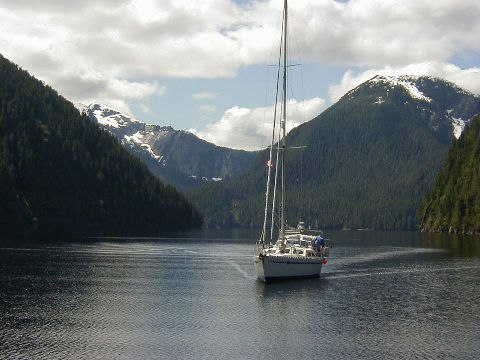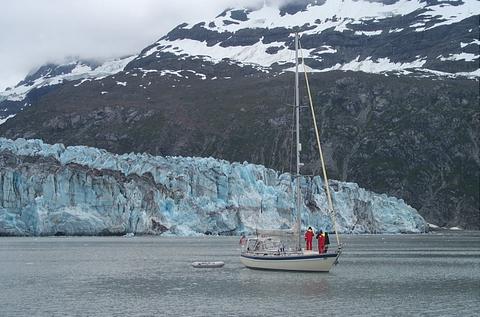Alaska 2002
During the summer of 2002, Lee and I took the boat north, from Blaine, Washington, to Glacier Bay, Alaska, via the inland passage. We were accompanied nearly the whole way there and back by our good friends and cribbage partners, Craig and Carol Lacy on their Sceptre 41, Waypoint.It's easy to be overwhelmed by the distance to Alaska and back. We started heading north from Blaine, Washington on 15 May 2002 and got to Port McNeill at the northern end of Vancouver Island, already getting a little cabin fever from being cooped up on the boat. I went into a local museum where they had a floor to ceiling map of the inland passage. After 2 weeks of travel, we were about up to my kneecaps, with six feet to go! It was then that I realized what a long trip this was going to be.
A couple of highlights.

The first was Roscoe Inlet, about 50 miles north of Shearwater. This seldom visited fjord had one other boat when we arrived, who left the next morning. We ended up staying two nights, we liked it so much. Traveling up Roscoe was like traveling up a watery Yosemite Valley —steep granite cliffs, covered with snow and an occasional waterfall, rose up out of the water to high mountains above. We couldn't get enough of it. We anchored at the bitter end of Roscoe Inlet, using a stern tie to an abandoned logging seawall. Oh, and I spent my 50th birthday there, under streaming sunshine.

The second highlight was Glacier Bay. Although far, it's worth it. The National Park Service limits the number of boats that can go into the Bay at any one time, so it has a feeling of serene, but harsh, isolation. When Vancouver visited the area in 1794, there was no Glacier Bay. It was completely filled with ice. All of the Bay as we know it today, is the result of 200+ years of receding glaciers. As a result, there is very little sediment at the bottom of the anchorages --- it was all scraped clean by the glaciers and hasn't had time to reaccumulate. This makes anchoring a challenge. You must have heavy gear, preferably with chain, particularly in anchorages such as Blue Mouse Cove or Reid Glacier.
If you decide to go to Glacier Bay, be sure to apply for your permit well in advance. Don't worry about the exact dates. We found that once we had a permit in hand, it was relatively easy to change or extend the days. Call every day until you get what you want!
Lessons Learned
Ironically, when the summers are nice in the Pacific Northwest, they are wet and cold in Alaska. This is because the North Pacific High sets up and shunts all those fronts up north, bypassing the Northwest, but soaking BC and Alaska!
To be reasonably comfortable, you need a boat with a snug cabin, a heater, and some way of piloting it without being out in the rain and cold. We found the enclosed cockpit of the Malö ideal for this. We spent many hours piloting the boat, snug under the canvas, with the heater going full blast! Some wiper blades (if you have a glass windscreen like the Malös) would be a good idea, but we found Rain-X to be a good substitute.
Frankly, I think powerboats are better at this than most sailboats. It's a long, long way up there and back (we did 3,000 miles) and at 6-7 knots, well, do the math. You spend a lot of time motoring, peering into the gloom! Because of the distances, we noticed that as we went north the boats got bigger and bigger and sailboats rarer and rarer. By the time we got to Juneau, we were about the smallest boat around, and one of the very few sailboats!
Most of the anchorages are of good quality. Some of them are amazingly bomb proof. However, they can be quite deep. We carry 300' of chain and there were times when every bit of it was over the side. It would be possible to cruise with less, but you will limit where you can anchor, particularly the farther north you go.
A good engine is essential. Winds are very light, and because you are nearly always going up or down a channel, they are either on the nose or over the stern — neither a particularly good point of sail. I would say we spent 90% of our time motoring! As a corollary, a good electric autopilot is a good idea.
Logs are a constant menace, particularly during the spring runoff. Despite our best efforts, we hit about a dozen of them, only one of which did any harm (it broke our speedometer impeller).
A problem for us was getting enough exercise. While BC and Alaska are gorgeous, those steep fjords and heavy woods mean there is no place to walk. You can spend days going from anchorage to anchorage, never setting foot on shore. On our return, by the time we got to Shearwater, both of us were having back pains, so we changed our strategy. Instead of seeking out isolation and wilderness, we started looking for a place, anyplace, where we could go for a walk. This helped enormously!
